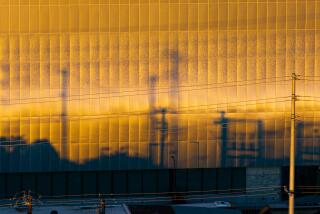No new nukes -- plants, that is
As the Senate debates climate legislation that could reinvent the country’s energy infrastructure, it is richly ironic that lawmakers who consider themselves rock-ribbed fiscal conservatives are among the strongest backers of nuclear plants -- a vastly expensive, inefficient and dangerous source of energy that requires massive taxpayer bailouts.
Senate Republicans and many moderate Democrats are seeking to lard up prospective climate and energy bills with billions of dollars in loan guarantees and other subsidies for nuclear power, even though it makes no sense as a solution to climate change and is a terrible option from an economic, environmental and national-security standpoint. Sens. John F. Kerry (D-Mass.) and Lindsey Graham (R-S.C.), whose bipartisan effort to restructure the cap-and-trade climate bill (which Republicans like to deride as “cap and tax”) offers its only hope of passage in the Senate this year, signaled their intent to add more nuclear pork to the bill in a recent Op-Ed article. Meanwhile, Sens. Jim Webb (D-Va.) and Lamar Alexander (R-Tenn.) recently introduced their own alternative climate bill calling for up to $100 billion in clean-energy loan guarantees, most of which would end up going to nuclear plants.
Nuclear energy is not a reasonable solution because plants take too long to build and cost far too much. Actually, it’s been so long since one has been built in this country that no engineering firm will even provide an estimate on the cost, but it’s safe to say that each new plant would run to several billion dollars. Because lenders aren’t willing to put up the money on such a risky investment, the nuclear industry is looking to Uncle Sugar. The last time there was a wave of nuclear construction in the United States, it took an average of nine years to build a plant, meaning we wouldn’t see the first one until at least 2018 -- too late to play any significant role in meeting the Senate climate bill’s goal of cutting emissions 20% by 2020.
Renewable power sources such as solar, wind and geothermal are getting cheaper over time, even as nuclear gets more expensive. And renewable-power plants can be built almost immediately, without the long permitting delays faced by nuclear reactors. Some clean-energy strategies, such as energy efficiency and combined heat and power systems, actually end up saving money rather than costing it. Nuclear advocates claim that reactors are needed because solar and wind power are intermittent -- generated only when the sun is shining or the wind is blowing -- but that’s a smoke screen.
The nation’s fleet of 104 nuclear plants supplies nearly 20% of our electricity. Building 100 more, as nuclear proponents have proposed, would supply a vast amount of carbon-free energy, and do so 24 hours a day without interruption. But then, so would geothermal power plants. Electricity can be generated by pumping water into hot, permeable rocks deep underground, and as the technology improves, the potential for geothermal is enormous. According to an MIT study, in fact, geothermal plants could eventually supply as much power as the nation currently gets from its nuclear reactors -- without producing any radioactive waste. And geothermal isn’t the only non-intermittent source of renewable power; others include solar thermal storage facilities and plants that generate electricity using biomass.
Most of the countries that have acquired nuclear weapons over the past quarter of a century have done so by adapting nuclear energy technology and materials, making reactors a primary cause of weapons proliferation. It would be the height of hypocrisy for the United States to make nuclear energy a mainstay of its clean-energy infrastructure while telling countries we don’t trust, such as Iran, that they can’t do the same. Further, no nation on Earth has yet met the engineering challenge of safely storing waste that will emit dangerous levels of radioactivity for hundreds of thousands of years.
Nuclear power is a failed experiment of the past, not an answer for the future. Every dollar invested in it is a dollar misdirected, one that should have gone to more efficient, cheaper and cleaner power sources.
More to Read
Inside the business of entertainment
The Wide Shot brings you news, analysis and insights on everything from streaming wars to production — and what it all means for the future.
You may occasionally receive promotional content from the Los Angeles Times.










